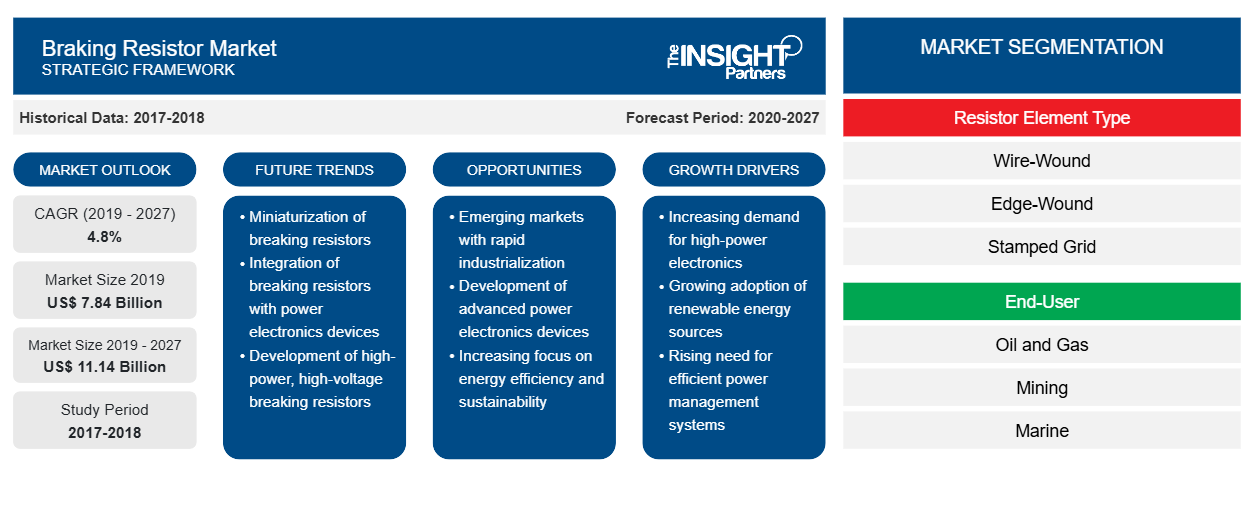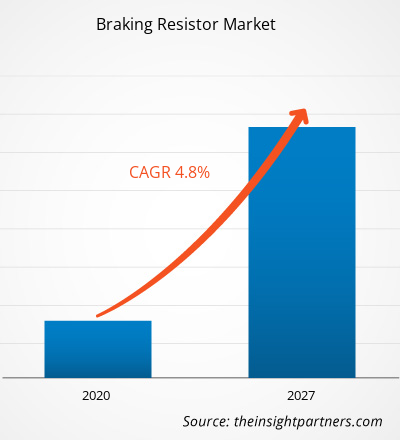The braking resistors market was valued at US$ 7,838.1 million in 2019 and is projected to reach US$ 11,141.9 million by 2027; it is expected to grow at a CAGR of 4.8% from 2020 to 2027.
A braking resistor or dynamic braking resistors (DBR's) work as alternative current (AC) variable frequency drives (VFDs) to disintegrate energy generated in the motor with the help of braking torque applied to stop the engine. This resistor has its application in the DC bus, which requires a voltage of around 800 volts when the braking conditions are applied. Dynamic braking resistors are used in DC drive systems and inverters, and also used as the electric traction motors in the railroad vehicle as generators while slowing down the locomotive. This dynamic resistor is also known as "rheostatic," as it generates electrical power, which is regenerative if the power is returned to the supply line and dissipated as heat in brake grid resistors. This resistor generates a braking torque and absorbs the extra energy generated at the time of stopping the electric motors. These resistors have their application across variable-speed drive systems such as cranes, elevators, and trains. Owing to the growing urbanization and industrial growth, energy consumption has increased manifolds. Therefore, to meet the rising requirements for power, the development of sub-transmission and intrastate transmission networks is increasing. The escalating demand for energy & power, owing to growing household incomes and increasing manufacturing and heavy industries, is boosting the market of braking resistor. Renewable energy plays a significant role for offering access to electricity. According to the International Energy Agency (IEA), the electricity demand is projected to grow at 2.1% per year by 2040 across the world. The demand for electricity in the Southeast Asia has been among the highest across the globe; it has potential for the renewable energy sector. All these factors are anticipated to boost the growth of the braking resistors market during the forecast period.
Europe dominated the braking resistors market in 2019, and is expected to continue its dominance during the forecast period. Tech investments in Europe increased in 2019 despite the economic slowdown caused by the tension between the UK and European Union (EU). Automotive manufacturers have 304 vehicle assembly plants and production plants in 27 countries across Europe. In 2019, the production of 4,371,499 units of commercial and passenger vehicles was reported. Growing production of commercial and passenger vehicles surges the demand for integration of braking resistors.
Customize This Report To Suit Your Requirement
You will get customization on any report - free of charge - including parts of this report, or country-level analysis, Excel Data pack, as well as avail great offers and discounts for start-ups & universities
Braking Resistor Market: Strategic Insights

-
Get Top Key Market Trends of this report.This FREE sample will include data analysis, ranging from market trends to estimates and forecasts.
Impact of COVID-19 Pandemic on Braking Resistors Market
The emergence and rapid spread of the novel coronavirus (COVID-19) has paralyzed numerous countries including developed as well as developing. The continuous surge in count of infected patients is threatening several industries across the globe. As of December 2020, the US, India, Brazil, Russia, and France are a few of the worst affected countries in terms of COVID-19 confirmed cases and reported deaths. The outbreak is adversely affecting economies and industries in various countries owing to lockdowns, travel bans, and business shutdowns. Moreover, the demand for braking resistors is decreasing at a prominent rate because the key braking resistors purchasing countries are lowering their investments in these components and utilizing a fair percentage of their budget to combat the COVID-19 outbreak. The temporary shutdown of manufacturing facilities is also hindering the growth of the braking resistors market. The continuity of the COVID-19 spread would restrain the growth of the braking resistors market players in coming years.
Market Insights
Mounting Inclination toward EVs Boosts Demand for Braking Resistor
The major players in the automotive sector are investing in the production of electric vehicles. Recently, remarkable collaborations have been undertaken between automakers and tech companies to develop technologically advanced electric vehicles. For instance, in December 2019, Fiat Chrysler collaborated with PSA Group, a French automaker to focus on electric vehicles' development. Further, increasing awareness about the rising levels of greenhouse gas emissions and the negative impacts of conventional vehicles are the major factors that encourage key players to invest in electric vehicles. Several major companies are looking forward to invest in startups, which can eventually help them co-create products in the future. For example, in March 2019, Hyundai, an automotive manufacturer headquartered in Seoul, South Korea, with its subsidiary Kia, invested US$ 300 million in Ola Electric to manufacture mobility solutions and cars specifically for the Indian population. The electric vehicles use regenerative braking, which recovers energy lost during braking and sends it back to the battery. As an alternative, it is beneficial to use a braking resistor to discharge the excess energy produced. These resistors are useful in case of any electrical fault, as well as to reduce the servicing costs due to diminished wear on the friction braking system. Moreover, the energy dissipated during dynamic braking into the resistor is also being used to heat the vehicle's trailer or cabin; therefore, decreasing the requirement for electrical heating that places an extra load on the battery.
Resistor Element Type-Based Market Insights
Based on resistor element type, the global braking resistors market is segmented into wire-wound, edge-wound, stamped grid, and others. Wire-wound resistor offers significant advantages such as excellent power dissipation, shock-proofing, and stable resistance. This resistor is used across several applications, basically as a power resistor, where larger amounts of power are dissipated. The wire-wound resistor includes a resistive wire, which is wound around a nonconductive material. Generally, the resistive wire is insulated so that adjacent wires do not short together.
End-User-Based Market Insights
Based on end-user, the braking resistors market is segmented into oil and gas, mining, marine, automobile and railways, energy, and others. Rise in demand for passenger cars and commercial vehicles, mostly in developing countries, is bolstering the need for braking resistors to control the speed and use the excess amount of energy dissipated. In 2014, China reported the production of 24 million vehicles, which is anticipated to increase and reach to around 364 and 607 million by 2030 and 2050, respectively. Several manufacturers worldwide are involved in developing different models of vehicles that demand the integration of braking resistors. Therefore, the rising integration of braking resistors across the automotive and railways market accelerates the braking resistors market growth.
Braking Resistor Market Regional InsightsThe regional trends and factors influencing the Braking Resistor Market throughout the forecast period have been thoroughly explained by the analysts at The Insight Partners. This section also discusses Braking Resistor Market segments and geography across North America, Europe, Asia Pacific, Middle East and Africa, and South and Central America.
Braking Resistor Market Report Scope
| Report Attribute | Details |
|---|---|
| Market size in 2019 | US$ 7.84 Billion |
| Market Size by 2027 | US$ 11.14 Billion |
| Global CAGR (2019 - 2027) | 4.8% |
| Historical Data | 2017-2018 |
| Forecast period | 2020-2027 |
| Segments Covered |
By Resistor Element Type
|
| Regions and Countries Covered |
North America
|
| Market leaders and key company profiles |
|
Braking Resistor Market Players Density: Understanding Its Impact on Business Dynamics
The Braking Resistor Market is growing rapidly, driven by increasing end-user demand due to factors such as evolving consumer preferences, technological advancements, and greater awareness of the product's benefits. As demand rises, businesses are expanding their offerings, innovating to meet consumer needs, and capitalizing on emerging trends, which further fuels market growth.

- Get the Braking Resistor Market top key players overview
Product development is the commonly adopted strategy by companies to expand their product portfolio. ABB Ltd., Vishay, Schneider Electric, Kanthal, and Yashkawa are among the key players implementing strategies to enlarge the customer base and gain significant share in the global braking resistors market, which in turn permits them to maintain their brand name. A few of the recent key developments are:
- In 2019, Yaskawa Electric Corporation’s R1000 regenerative unit avoids energy to waste. Instead, it is delivered back to the power source that could be used by other loads. The R1000 regenerative unit is a safer solution for regeneration than the open heating element used in dynamic braking resistors.
- In 2018, Vishay Intertechnology, Inc. exhibited its latest resistors for oil and gas, industrial, traction, and renewable energy power systems at the 2018 IEEE PES T&D conference and expo.
Braking Resistors Market Segmentation:
By Resistor Element Type
-
- Wirewound
- Edge-wound
- Stamped Grid
- Others
By End-User
-
- Oil and Gas
- Mining
- Marine
- Automobile and Railway
- Energy
- Others
Company Profiles
- ABB Ltd.
- Bonitron
- Captech Pty Ltd.
- CRESSALL RESISTORS LTD.
- REO AG
- Sandvik AB(Kanthal)
- Schneider Electric
- Toshiba International Corporation
- Vishay Intertechnology, Inc.
- Yaskawa Electric Corporation
Frequently Asked Questions
Which end-user type is expected to dominate the market in the forecast period?
What are market opportunities for braking resistor?
What are reasons behind braking resistor market growth?
- Historical Analysis (2 Years), Base Year, Forecast (7 Years) with CAGR
- PEST and SWOT Analysis
- Market Size Value / Volume - Global, Regional, Country
- Industry and Competitive Landscape
- Excel Dataset
Recent Reports
Testimonials
Reason to Buy
- Informed Decision-Making
- Understanding Market Dynamics
- Competitive Analysis
- Identifying Emerging Markets
- Customer Insights
- Market Forecasts
- Risk Mitigation
- Boosting Operational Efficiency
- Strategic Planning
- Investment Justification
- Tracking Industry Innovations
- Aligning with Regulatory Trends





















 Get Free Sample For
Get Free Sample For